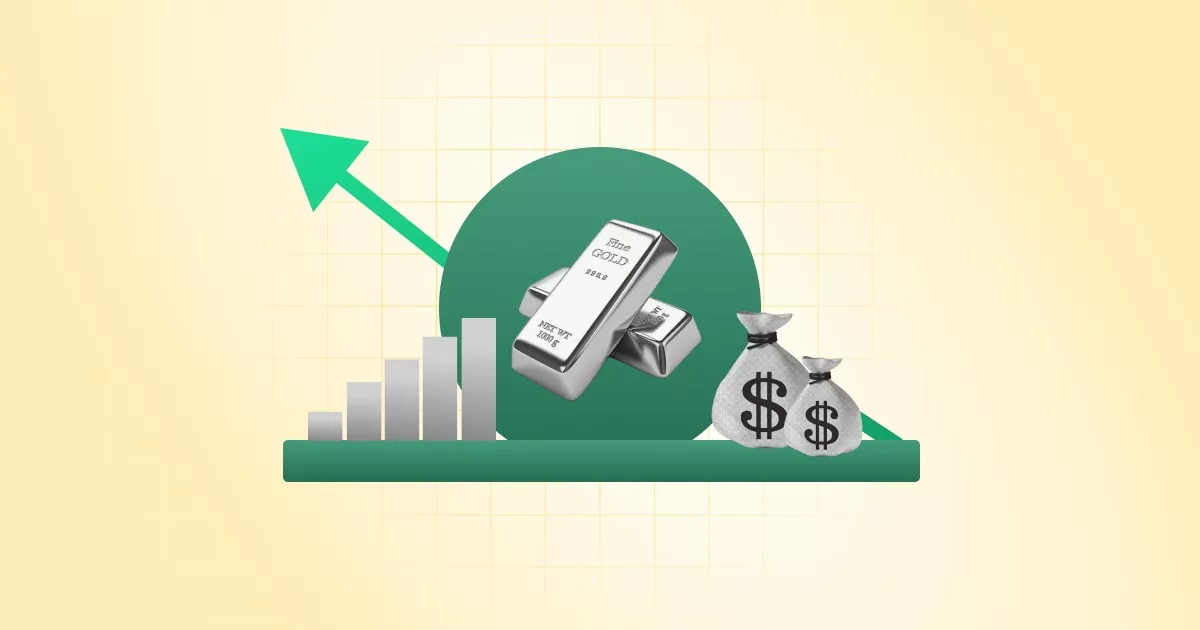
Gold has always been a symbol of wealth and prosperity in India, with a rich history that dates back thousands of years. Even today, gold remains an attractive investment option for Indians. It offers a hedge against inflation and a safe haven during economic uncertainty. Whether you’re a seasoned investor or just starting out, there are different ways to invest in gold in India. Each investment option has unique features and benefits, from physical gold to sovereign gold bonds.
So, let’s look at these different ways to invest in gold and determine which is best for you.
Why Invest in Gold?
Gold has been an object of fascination and desire since the dawn of human civilization. It has been used for thousands of years as currency, jewelry, and a symbol of wealth and power.
Look at its history to find out why investing in gold can be an intelligent choice.
Gold has been used as currency for over 2,500 years and has played a critical role in developing world economies. In fact, the gold standard was used as the basis for many currencies until the mid-20th century. Today, gold is still widely accepted as a currency and used as a hedge against inflation and other economic uncertainties.
As per its historical returns, gold can act as a long-term investment. For example, from 1947 to 2021, gold had an average annual return of 8.9%.
Gold is also a good hedge against inflation. When inflation rises, the value of the paper currency tends to decline, but the value of gold tends to increase. This is because gold is a limited resource and cannot be printed or created like paper money. As a result, gold can help protect your purchasing power during inflationary periods.
In addition, gold is a safe-haven asset that can protect during economic uncertainty or market volatility. During periods of economic crisis, investors tend to flock to safe-haven assets such as gold, which can help protect their portfolios from losses.
Risks and Challenges of Investing in Gold
While gold can be a smart investment choice, like any investment, it comes with risks and challenges.
Let us highlight one particular story to showcase the risk associated with Gold.
In 1962, India faced a severe balance of payments crisis.
A balance of payment is the difference between its inflow and outflow of foreign currency.
A balance of payment crisis occurs when a country’s balance becomes unsustainable. This can happen when a country’s imports exceed its exports or when it borrows too much from foreign lenders. As a result, the country may not have enough foreign currency to pay for its imports or service its debts, leading to a currency devaluation or even default.
In India’s case, the high demand for gold imports was eating into the foreign exchange reserves.
How did India handle this?
To handle this crisis, the Indian government introduced the ‘Gold Control Act’ to regulate the possession and sale of gold in India. The primary objective of this act was to control the demand for gold and to conserve the country’s foreign exchange reserves.
Under this act, individuals were required to declare their gold holdings and deposit them with authorized banks or face penalties, including imprisonment.
In 1968, the government went a step further. It announced the ‘gold confiscation scheme.’
It required individuals to surrender their gold holdings to the government in exchange for cash. The scheme addressed the balance of payments crisis by reducing the demand for gold import. The scheme was not well received, and many people protested against it.
Eventually, the government had to modify the scheme and offer a better exchange rate for gold to appease the public. The gold confiscated during the scheme was melted down and used to mint coins sold to the public at a premium.
The gold confiscation episode is a reminder of the risks associated with investing in gold, particularly in times of economic crisis.
Below are some of the other risks of investing in gold.
1. Price Volatility
One of the most significant risks of gold is its price volatility. The price of gold can fluctuate rapidly in response to various economic and geopolitical factors, making it difficult to predict and manage risk.
2. Currency Fluctuations
Gold is priced in US dollars, so fluctuations in currency exchange rates can affect the value of gold investments for investors in other countries.
3. Storage and Insurance Costs
Physical gold must be stored securely. This can be expensive, as storage fees and insurance costs can eat into returns.
4. Liquidity Risk
Gold is less liquid than other investments, such as stocks and bonds. It may be difficult to sell gold quickly at a fair price in a market downturn.
5. Counterparty Risk
When investing in gold through financial products such as ETFs or gold futures, there is a counterparty risk that the issuer may default on their obligations.
6. Opportunity Cost
Investing in gold may mean missing out on potentially lucrative investment opportunities in other asset classes, such as crypto or stocks.
5 Different Ways to Invest in Gold in India
Below are the five different instruments for investing in Gold
1. Gold ETFs
Gold Exchange-Traded Funds (ETFs) are mutual funds that invest in physical gold of 99.50% purity.
They are traded on the stock exchange just like stocks. It provides investors with an easy way to invest in gold without physically holding the metal.
Features
- There are no storage and security costs involved in Gold ETFs.
- Gold ETFs are traded on the stock exchange, making it easier for investors to buy and sell them
Minimum Investment
The amount is equivalent to the current price of 1 gram of gold.
Return Potential
Gold ETFs give investors the same return as the physical gold price movements minus the fund’s expense ratio.
Investment Tenure
There is no minimum or maximum investment tenure for Gold ETFs.
Disadvantage
Investors must incur ETF’s expense ratio, which can eat into returns.
How to Invest
- Investors can invest in Gold ETFs through a broker or trading platform that offers access to the stock exchange.
- Buying and selling Gold ETFs is similar to buying and selling stocks on the stock exchange.
2. Gold Funds
Gold Funds are mutual funds that invest in gold-related investments (like Gold ETFs) rather than physical ones.
Features
Gold funds are managed by professional fund managers.
Minimum Investment
One can start investing in a Gold Fund with a minimum of INR 1,000.
Return Potential
The return potential of gold funds can vary depending on the performance of the gold-related investments in which the fund invests.
Investment Tenure
There is no minimum or maximum investment tenure for gold funds.
Disadvantages
- Investors must incur the fund’s expense ratio, which can eat into returns.
- Investors must also pay an exit load to redeem the fund’s units before one year is completed.
How to Invest
- Investors can invest in gold funds through a broker or trading platform that offers access to mutual funds.
- Investors can redeem their funds only at the end of the day.
3. Sovereign Gold Bonds
Sovereign Gold Bonds (SGBs) are government securities issued by the Reserve Bank of India (RBI) on behalf of the government.
Unlike physical gold, SGBs are digital or paper bonds denominated in grams of gold.
Features
- SGBs are backed by a sovereign guarantee.
- SGBs are issued periodically, and investors can buy them from authorized banks and post offices during the issuance period.
Minimum Investment
They are denominated in grams of gold, with a minimum investment of one gram and a maximum of four kilograms for individuals and Hindu Undivided Families (HUFs).
Return Potential
- SGBs offer investors the same return as physical gold.
- SGBs also provide an additional interest rate of 2.5% per annum on the initial investment.
Investment Tenure
SGBs have a fixed tenor of eight years, with an exit option available after the fifth year.
Disadvantages
- SGBs are not entirely risk-free, as they are subject to the government’s credit risk.
- There is also a liquidity risk associated with SGBs, as they cannot be quickly sold in the secondary market.
How to Invest
- Investors can invest in SGBs through authorized banks and post offices during issuance.
- Investors can hold the bond in either the dematerialized or physical form.
4. Digital Gold
Digital Gold is an investment product allowing investors to buy and own physical gold digitally. It is offered by various digital platforms and is backed by actual gold, stored in secured vaults on behalf of investors.
Its relatively new investment option has gained popularity in India due to its convenience and accessibility.
Features
All these gold are 24K and are certified by the government. It ensures purity and negates the chances of fraud.
Minimum Investment
The minimum amount one can buy is as low as one rupee.
Return Potential
The returns on digital gold are similar to physical gold, minus any transaction and storage fees charged by the digital platform.
Investment Tenure
There is no fixed maturity date. Investors can buy and sell digital gold as per their investment goals and market conditions.
Disadvantages
- There is a risk of loss of value due to transaction and storage fees charged by the digital platform.
- Investors should also be aware of the credit risk associated with the digital platform, as it is not backed by the government or any regulatory authority.
How to Invest
- Investors can invest in digital gold through digital platforms such as Paytm, PhonePe, and Google Pay.
- Investors can digitally hold or redeem their holdings for physical gold or cash.
5. Physical Gold
Physical gold refers to actual metal in the form of coins or bars that can be bought and sold in the market. It is one of the oldest and most traditional forms of investing in gold.
Features
- It can be bought as coins or bars from authorized dealers or banks.
- The purity and weight of the gold are certified, making it a reliable investment option.
Minimum Investment
The amount is equivalent to the current price of 1 gram of gold.
Return Potential
The return potential of physical gold is linked to its prevailing market price.
Investment Tenure
The investment tenure for physical gold is flexible, and investors can hold it for as long as they want.
Disadvantages
Physical gold is susceptible to theft and damage, and investors must ensure proper storage and security arrangements.
How to Invest
- Investors can buy physical gold through coins or bars from authorized dealers or banks.
- Investors should ensure proper storage and security arrangements for the physical gold by keeping it in a bank locker or a secure location at home.
Conclusion
Gold has always been an attractive investment option in India. From physical gold to sovereign gold bonds, investors have many options. But, evaluating your investment goals, risk tolerance, and horizon is vital before investing in gold.
By staying informed about the gold market, you can make the most of your gold investments and potentially reap the benefits of this precious metal.
FAQs
1. What are the tax implications of investing in gold in India?
In India, gold investments are subject to capital gains tax, with the tax rate varying depending on the holding period.
Short-term capital gains (investments held for less than 3 years) are taxed at the investor’s income tax rate.
Long-term capital gains (investments held for more than 3 years) are taxed at a flat rate of 20% with indexation benefits.
2. Is gold a good long-term investment?
Gold has historically been an excellent long-term investment as it has maintained its value over time and has provided a hedge against inflation.
But gold’s returns may not be as high as other investments like stocks and cryptos, and it can be highly volatile in the short term.
Thus, it’s important to diversify your portfolio and consider your investment objectives, risk tolerance, and investment horizon when investing in gold for the long term.
3. How can I manage the risks of investing in gold?
To manage the risks of investing in gold, it’s important to diversify your portfolio and not allocate a significant portion to gold.
You can also consider investing in different gold instruments, such as physical gold, ETFs, funds, and sovereign gold bonds.





